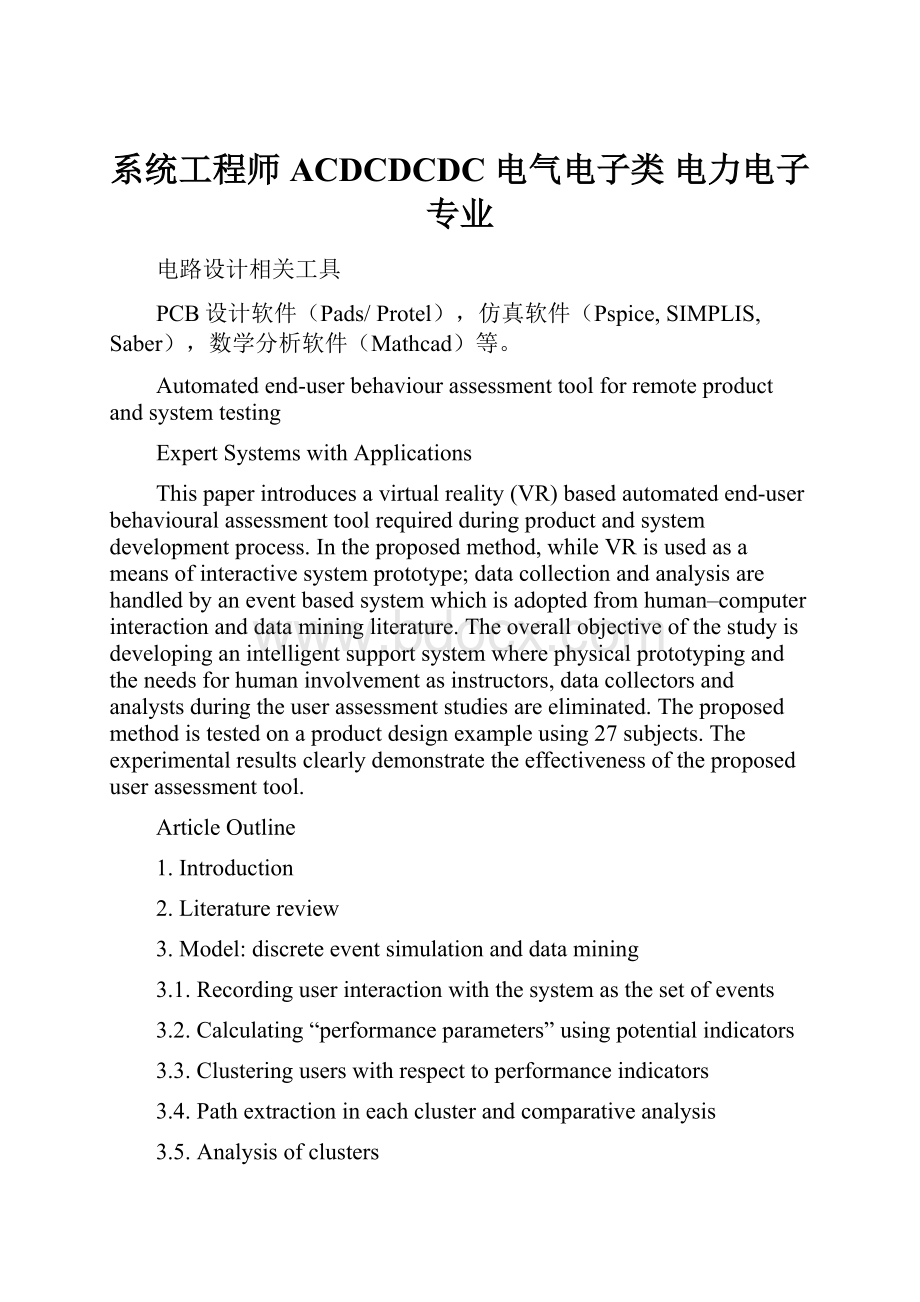系统工程师ACDCDCDC 电气电子类 电力电子专业.docx
《系统工程师ACDCDCDC 电气电子类 电力电子专业.docx》由会员分享,可在线阅读,更多相关《系统工程师ACDCDCDC 电气电子类 电力电子专业.docx(32页珍藏版)》请在冰豆网上搜索。

系统工程师ACDCDCDC电气电子类电力电子专业
电路设计相关工具
PCB设计软件(Pads/Protel),仿真软件(Pspice,SIMPLIS,Saber),数学分析软件(Mathcad)等。
Automatedend-userbehaviourassessmenttoolforremoteproductandsystemtesting
ExpertSystemswithApplications
Thispaperintroducesavirtualreality(VR)basedautomatedend-userbehaviouralassessmenttoolrequiredduringproductandsystemdevelopmentprocess.Intheproposedmethod,whileVRisusedasameansofinteractivesystemprototype;datacollectionandanalysisarehandledbyaneventbasedsystemwhichisadoptedfromhuman–computerinteractionanddataminingliterature.Theoverallobjectiveofthestudyisdevelopinganintelligentsupportsystemwherephysicalprototypingandtheneedsforhumaninvolvementasinstructors,datacollectorsandanalystsduringtheuserassessmentstudiesareeliminated.Theproposedmethodistestedonaproductdesignexampleusing27subjects.Theexperimentalresultsclearlydemonstratetheeffectivenessoftheproposeduserassessmenttool.
ArticleOutline
1.Introduction
2.Literaturereview
3.Model:
discreteeventsimulationanddatamining
3.1.Recordinguserinteractionwiththesystemasthesetofevents
3.2.Calculating“performanceparameters”usingpotentialindicators
3.3.Clusteringuserswithrespecttoperformanceindicators
3.4.Pathextractionineachclusterandcomparativeanalysis
3.5.Analysisofclusters
3.5.1.ApproachI
3.5.2.ApproachII
3.6.Evaluationofclusteranalysisapproaches
4.Experimentalset-up:
assemblysimulationanddataanalysis
4.1.Thesimulation:
assemblyofabookshelf
4.2.Processmodel
4.3.Dataanalysis
4.3.1.Performanceindicators:
completiontime,cancellationsandrepetitionsandclustering
4.3.2.FindingpreferredpathsinUserlogsinthesamecluster
4.3.3.Evaluationofresults
5.Conclusion
SPECIES—Co-evolutionofproducts,processesandproductionsystems
CIRPAnnals-ManufacturingTechnology
Manufacturingenterprisesarechangingthewaytheybehaveinthemarkettofacetheincreasingcomplexityoftheeconomic,socio-politicalandtechnologicaldynamics.Manufacturingproducts,processesandproductionsystemsresultinbeingchallengedbyevolvingexternaldrivers,includingtheintroductionofnewregulations,newmaterials,technologies,servicesandcommunications,thepressureoncostsandsustainability.Theco-evolutionparadigmsynthesisestherecentscientificandtechnicalapproachesproposedbyacademicandindustrialcommunitiesdealingwithmethodologiesandtoolstosupportthecoordinatedevolution(co-evolution)ofproducts,processesandproductionsystems.Thispaperaimsatreviewingandsystemisingtheresearchcarriedoutinthefieldofmanufacturingco-evolutionwithaparticularfocusonproductionsystems.Anintroductoryinvestigationofvariousindustrialperspectivesontheproblemofco-evolutionispresented,followedbythedescriptionoftheco-evolutionmodelandthemethodologyadoptedforframingtheexistingscientificcontributionsintheproposedmodel.Then,thecorepartoftheworkispresented,consistinginasystemisedanalysisofthecurrentmethodologiesdealingwithco-evolvingproduct,processandsystemandadescriptionofproblemsthatremainunsolved,thusmotivatingfutureresearchstrategiesandroadmaps.
ArticleOutline
1.Introductionandproblemstatement
1.1.Industrialmotivation
1.1.1.Industrialequipmentusers
1.1.2.Industrialequipmentproducers
1.1.3.DigitalEnterpriseTechnologies(DET)
1.2.Theco-evolutionparadigm
2.Proposedframework:
theco-evolutionmodel
2.1.Objectivesoftheframework
2.2.Fundamentaldefinitions
2.3.Integrationandco-evolutionofproducts,processesandproductionsystems(P3S)
2.3.1.Integration
2.3.2.Impactofcompanyorganisation
2.3.3.Evolution
2.3.4.Evolutiondynamics
2.4.Theroleofthestrategy
2.4.1.Themanufacturingstrategy
2.4.2.Companystrategy
3.Stateoftheartanalysis
3.1.Classificationmethodology
3.2.Bibliographicsearch
3.3.Usingtheco-evolutionparadigmtoclassifyexistingscientificliterature
4.Methodologiestodrivetheco-evolutionofproducts,processesandproductionsystems(P3S)
4.1.Integratedknowledgemanagement
4.1.1.KnowledgemanagementforintegratedP3S
4.1.2.KnowledgemanagementforevolvingP3S
4.2.Configurationofco-evolvingproductionsystems
4.2.1.Performanceevaluationofco-evolvingproductionsystems
4.2.2.Useofthesystemco-evolutionenablers
4.2.3.Selectionofthesystemco-evolutionenablers
4.2.4.Definitionoftheproductionsystemandresourcearchitecture
4.3.Controlofevolvingproductionsystems
4.4.Productionplanningandschedulingunderuncertainty
4.5.Evolutionaryprocessplanning
4.6.ControlofthedynamicsofP3Sco-evolution
4.6.1.Factorycontrol
4.6.2.Productionnetworkcoordination
4.6.3.Manufacturingstrategy
4.7.Implementationofco-evolution
4.7.1.Newbusinessmodels
4.7.2.Complexityandco-evolution
4.7.3.Reconfigurability,flexibility,adaptability,changeabilityandco-evolution
4.7.4.Guidelinesforindustrialapplications
4.7.5.Co-evolutionandresearchpolicies
5.Futureresearchpriorities
6.Conclusions
Acknowledgements
Optimizingcustomer'sselectionforconfigurableproductinB2Ce-commerceapplication
ComputersinIndustry
ManycompaniesprovideconfigurableproductsonInternettosatisfycustomers’diversifiedrequirements.Mostofbusiness-to-consumer(B2C)e-commercesoftwaresystemsusetree-orwizard-likeapproachestoguidecustomersinconfiguringacustomizedproductonInternetwebpages.However,customersmayfeelconfusedwhiletheyareselectingcomponentsofaproductfromoptionlists,sincetheyareusuallynotfamiliarwiththetechnicaldetailsofthesecomponents.Afewe-commercesitesuserecommendationsystemstoprovidesuggestedproductsforcustomers,buttheyhavetomaintainuserprofilesandhavelimitationssuchasnewuserproblemandcomplexity.Therefore,theymaynotbesuitableforsmallandmedium-sizedenterprises.Thisresearchproposesanewapproachtohelpcustomersconfiguretheirexpectedproducts.Byusingthisapproach,onceacustomerinputsthelevelsofimportanceofrequirements,totalbudgetoftheexpectedproduct,thesoftwaresystemcanfigureoutacustomizedproductwhichmaximallymeetsthecustomer'sexpectations,andcanalsoprovidethesuboptimalsolutionsforfurtherselections.Amathematicalmodeltoformulatethisoptimizationproblemisestablished.Acasestudyisusedtodemonstratethefeasibilityandeffectivenessofthisapproach.
ArticleOutline
1.Introduction
2.Literaturereview
2.1.Productfamily
2.2.Productconfiguration
2.3.Recommendationsystems
3.Modelingofcomponentsselection
3.1.TranslateCRstoTAs
3.2.Dealingwithcontributionsofproductcomponents
3.3.Componentcompatibility
3.4.Productprice
3.5.Optimizationmodel
3.6.Near-optimalsolutionspool
4.Illustrativeexample
5.Discussions
6.Conclusions
Acknowledgements
Newtrendsfordesigntowardssustainabilityinchemicalengineering:
Greenengineering
趋向于绿色工程/产业的化学工程可持续化设计
ChemicalEngineeringJournal化学工程学报
Abroadreviewofdisciplinesandtechnologiesconcerningthelast-decade-advancesandstate-of-the-artintheunderstandingandapplicationofsustainabilityfromaChemicalEngineeringviewpointispresented.Uptonowitwashardtofindusefulsustainabilitycriteriaandready-to-useguidancetoolsforthedesignofproducts,processesandproductionsystems.Fortunately,inthelastdecadearangeofpracticesanddisciplineshaveappearedtransformingthewayinwhichtraditionaldisciplineswereconceived.Firstly,areviewoftheconceptofsustainabilityanditssignificanceforthechemicalandprocessindustryispresented.Then,severalinspiringphilosophiesanddisciplineswhicharethebasisofthenewtrendsindesignarebrieflyreviewed,namely,TheNaturalStep,Biomimicry,CradletoCradle,GettingtoZeroWaste,ResilienceEngineering,InherentlySaferDesign,EcologicalDesign,GreenChemistryandSelf-Assembly.ThecoreofthemanuscriptisadeepreviewofwhathasbeendoneinGreenEngineeringsofar,includingitsmaindefinitionsandscopeofapplication,differentguidingprinciples,frameworksfordesignandlegislativeaspects.ArangeofillustrativeindustrialapplicationsandseveraltoolsorientedtoGEareanalysed.Finally,someeducationalconsiderationsandtrainingopportunitiesareincluded,providingeducationatacademicanduniversitylevelsallowsforthecreationofacriticalmassofengineersandscientiststofostergreenengineeringandsustainabledevelopmentinthefuture.
ArticleOutline
1.Introduction
2.Thegoalofsustainabilityinthechemicalandprocessindustry
2.1.Definitionoftheterm
2.2.Interpretation
2.3.Targetdimensions
2.4.Postulatesspecification
2.5.Measurementandevaluation:
indexesofsustainability
2.6.Resources
3.Baseinspirationphilosophiesandotherrelateddisciplines
3.1.Designphilosophy
3.1.1.TheNaturalStep
3.1.2.Biomimicry
3.1.3.Cradle-to-cradle.remakingthewaywedesignthings
3.1.4.Gettingtozerowaste
3.1.5.Resilienceengineering
3.2.Safety
3.2.1.Inherentlysaferdesign,ISD
3.3.Facilitiesandbuildings
3.3.1.Ecologicaldesign:
buildingsfortheenvironment
3.4.Thechemistryandtheprocess
3.4.1.Greenchemistry
3.4.1.1.ExampleofGCinthepharmaceuticalindustry
3.4.1.2.ExamplesofGCinthechemicalindustry
3.4.2.Self-assembly:
buildinginanaturalway
4.Greenengineering
4.1.Definitionandscopeofapplication
4.2.Approachingsustainabilitythroughprinciples
4.3.Greenengineeringframeworksfordesign
4.3.1.RenewedEuropeanpolicyforchemicals,REAC